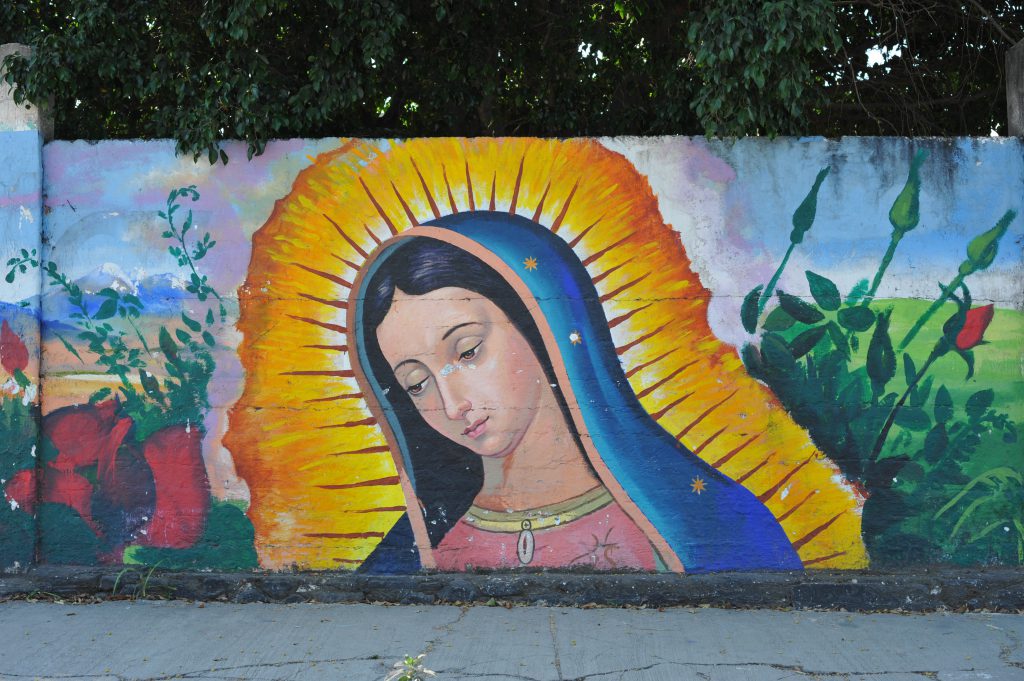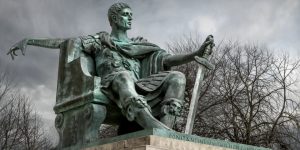Imagine waking up one day and going about your regular routine, when suddenly something happens that will not only change your life but the lives of Catholics and Mexicans forever.
At dawn on December 9, 1531, Juan Diego, who was a young Aztec Indian from the village of Cuautitlán, was on his way to attend weekly mass at the Franciscan church at Tlatelolco. He had recently converted to Catholicism, and the church was a few miles away from his uncle’s house, where he lived at after the death of his parents. While taking a shortcut over the hill of Tepeyac, he heard his name being called, and at the same time he heard music and the singing of birds.1 He followed the sounds and heard someone calling to him from the peak of the hill, “Juanito, Little Diego.” When he reached the top of the hill, he saw a young lady standing there who motioned for him to come closer: “Juanito, the smallest of my sons, where are you going?” He answered: “My Lady and my child, I have to go to your house in Mexico, Tlatelolco.” She declared herself to be “the eternal Virgin, holy Mother of the true God” and “merciful Mother” of men.2 She told Juan Diego to go to the bishop of Mexico, the Spaniard Fray Juan de Zumarraga, and tell him that she wished to have a church built on the hill of Tepeyac.3 This was the start of a life-changing moment for Juan Diego and soon, for Catholics all over the world.

Later that day, Juan Diego made his way to the bishop’s palace, which was about four miles away, and after some difficulty with the guards, he was eventually admitted to the bishop’s study, and he delivered the message from the Virgin Mary and told him everything that he admired, saw, and heard.4 The Bishop answered: “You will come again, my child, and I will think about the message you have brought.”5 Zumarraga was sympathetic but not convinced by the story that Juan Diego told him. As the first Catholic bishop of Mexico, he had heard many wild stories from converted Indians, and needed more time to think about it. In the recent decade, the colony of New Spain had been established after Hernan Cortes conquered the Aztecs in 1521. One of the goals of the Spanish was to convert the native indigenous population to Christianity. However, this was a very slow process. In many areas, the old religious practices were still being maintained a decade later. Some of the beliefs of the natives were incorporated into their own form of Christianity.6 Juan Diego left the bishop’s palace feeling very sad and returned to the hill where he had previously seen the Virgin, and explained to her what happened with the bishop, and suggested that it would be a better idea for her to send someone more important than he was to the bishop. The Virgin reassured him that he was the chosen one, and directed him to visit the bishop again the following day.7
The next day, on December 10, Juan Diego returned to the bishop’s palace and asked him if they could build the church for the Virgin Mary. The bishop asked him many questions in order to test his truthfulness, such as where he had seen her and how she looked, and Juan Diego answered everything precisely to the bishop.8 The bishop listened carefully but said he would need some proof before building a church for her. He directed Juan Diego to bring back an unmistakable sign for the validation of the apparitions that occurred. After Juan Diego left, the bishop then sent two of his staff to follow him and report back what they had seen. Juan Diego went back to the hill at Tepeyac and the staffers that were following him lost sight of him and returned back to the bishop’s palace. Meanwhile, Juan Diego had seen the Virgin Mary again, and told her the answer that the bishop had given him. She told him to come back the following day and she would give him a sign for the bishop.9
When he returned home, Juan Diego found his uncle, Juan Bernardino, seriously ill and at the point of dying. He nursed him all through the night. In the morning, he decided to call on a priest from the church at Tlatelolco to administer the last rites, as his uncle’s health was not improving. Juan Diego was worried that he had failed to meet with the Virgin Mary, and took the longer and lower road to Tlatelolco instead of the shortcut over the hill of Tepeyac. But the Virgin appeared on the lower path and told him that there was no need to worry about his uncle Bernardino, whom she had visited and was now cured. She then told Juan to go back to the top of the hill, where he would find many flowers growing. His mission was to pick a bunch of the flowers, wrap them in his cloak, and take them to the bishop. The Virgin stressed that these flowers must be concealed and not shown to anyone else.10

The top of the hill was not a place where flowers would usually grow, because of thorns, thistles, cactus, and small weeds. And it was the month of December, when everything is killed by the frost. However, he found some beautiful and fragrant roses growing, so he picked a bunch, wrapped them in his cloak, and headed down towards the Virgin to show her what he had discovered. The Virgin took them in her hands and told him that this bunch of flowers was the proof that he needed to show the bishop, and in showing him, the bishop would believe all that Juan Diego had said.11 He picked up the bunch of flowers, wrapped them in his cloak, and headed towards the bishop’s palace one last time, and upon arrival, the guards demanded to know what he was carrying in his cloak. The guards could smell the flowers and when they opened the cloak, the roses were fresh, fragrant, fully open, and precious. They took the cloak away from Juan and attempted to grab some of the flowers, but once they had opened it again and reached to grab some, the roses had become painted flowers on the inside of the cloak. They took Juan to the bishop and when he unfolded his white cloak to the bishop, the fresh roses spilled out onto the floor. When the various roses fell on the floor, the bishop saw that on the inside of the cloak where the flowers once had been, a portrait of the Virgin Mary appeared.12

When the bishop and all that were present saw this image, they fell to their knees in admiration. The bishop took the cloak to his chapel, where he then prayed and thanked God and the Virgin for the miracle. The bishop, astounded by this miracle, asked to be taken to where Juan Diego had seen the Virgin Mary. Upon arrival at the hill of Tepeyac, the bishop ordered that the church that the Virgin Mary had requested to be built would indeed be built, and would be named “The Basilica of Our Lady of Guadalupe,” which is located in present-day Mexico City. The cloak with the picture of Our Lady of Guadalupe can be found at this church that was built in her honor.13
It has been said that the dark-skinned image of Mother Mary as a virginal Native American girl helped the Spanish priests convert millions of Mexican Indians to Catholicism.14 Occasionally, we encounter a symbol that seems to enshrine the major hopes and aspirations of an entire society. Such a master symbol is represented by the Virgin of Guadalupe, Mexico’s patron saint. Her image was not only used during wars and battles as a figure of protection, but is also still used to adorns house fronts, churches and home altars, restaurants, and so much more. Her shrine at Tepeyac is visited each year by hundreds of thousands of pilgrims that all go to honor her.15 To the present day, Our Lady of Guadalupe remains a powerful symbol of Mexican identity and faith, and her image is associated with everything from motherhood to feminism to social justice. Her image has often graced the banners of those struggling for Mexican independence, and she has been understood by many devotees to side with oppressed and poor people. Mexican immigrants to the United States brought with them their devotion to her—privately and affectionately called “La Morenita”—and have helped to perpetuate her identification with others.16 After the apparitions of the Virgin Mary occurred, many Catholics began to honor her and see her as their own mother, especially Mexicans since they often refer to her as “nuestra Madre” or “Our Mother” and adopted her as their own. The feast of Our Lady of Guadalupe is celebrated every December 12, which became a national holiday in Mexico in 1859, and she has been recognized as the patron saint of Mexico.17

- Encyclopedia of Occultism and Parapsychology, 2001, s.v. “Guadalupe Apparitions (of the Virgin Mary)”, by J. Gordon Melton. ↵
- Samuel Marti, The Virgen of Guadalupe and Juan Diego (Ediciones Euroamericanas, 1973), 36-38. ↵
- Encyclopedia of Occultism and Parapsychology, 2001, s.v. “Guadalupe Apparitions (of the Virgin Mary)”, by J. Gordon Melton. ↵
- Encyclopedia of Occultism and Parapsychology, 2001, s.v. “Guadalupe Apparitions (of the Virgin Mary)”, by J. Gordon Melton. ↵
- Samuel Marti, The Virgen of Guadalupe and Juan Diego (Ediciones Euroamericanas, 1973), 39. ↵
- Global Events: Milestone Events Throughout History, 2014, s.v. “The Virgin of Guadalupe Appears to Juan Diego”, by Jennifer Stock. ↵
- Encyclopedia of Occultism and Parapsychology, 2001, s.v. “Guadalupe Apparitions (of the Virgin Mary)”, by J. Gordon Melton. ↵
- Samuel Marti, The Virgen of Guadalupe and Juan Diego (Ediciones Euroamericanas, 1973), 43. ↵
- Encyclopedia of Occultism and Parapsychology, 2001, s.v. “Guadalupe Apparitions (of the Virgin Mary)”, by J. Gordon Melton. ↵
- Encyclopedia of Occultism and Parapsychology, 2001, s.v. “Guadalupe Apparitions (of the Virgin Mary)”, by J. Gordon Melton. ↵
- Samuel Marti, The Virgen of Guadalupe and Juan Diego (Ediciones Euroamericanas, 1973), 48. ↵
- Encyclopedia of Occultism and Parapsychology, 2001, s.v. “Guadalupe Apparitions (of the Virgin Mary)”, by J. Gordon Melton. ↵
- Global Events: Milestone Events Throughout History, 2014, s.v. “The Virgin of Guadalupe Appears to Juan Diego”, by Jennifer Stock. ↵
- The Gale Encyclopedia of the Unusual and Unexplained, 2003, s.v. “Virgin of Guadalupe,” by Brad Steiger and Sherry Hanson Steiger. ↵
- Eric R. Wolf, “The Virgin of Guadalupe: A Mexican National Symbol,” The Journal of American Folklore 71, no. 279 (1958): 1. ↵
- Contemporary American Religion, 1999, s.v. “Virgin of Guadalupe,” by Sandra L. Zimdars-Swartz. ↵
- Contemporary American Religion, 1999, s.v. “Virgin of Guadalupe,” by Sandra L. Zimdars-Swartz. ↵



103 comments
Eva Lizarraga
I remember visiting the Basilica of Our Lady of Guadalupe once, but I honestly didn’t have as good of an understanding of the history of it as I do after reading this article. I remember the church being very beautiful and full of roses, and this article explains why! While reading, I found it especially interesting that by her being a dark-skinned woman, she was able to influence millions of Mexican Indians to Catholicism. It really shows what an effect representation can have on the lives of so many people.
Sara Alvirde
I also relate to Aaron Peters’s comment. I have not that much knowledge of the Virgin of Guadalupe myself and had never heard the story before. It was beautiful to read and so amazing that Juan Diego would be so impacting on the Mexican Indians to convert to Catholicism.
Aaron Peters
As someone with almost no knowledge of the Virgin of Guadalupe and the story behind her, I appreciate the amount of detail and background information you provided. The article was an interesting window into Mexican and Catholic history, and how those two cultures blended. I found the image of the darker-skinned Virgin Mary to be the embodiment of this unique fusion, with so much history to it dating back over 500 years. Great Article!.
Grace Frey
Nicole, I love the story of the Virgin of Guadalupe. Like many of the commenters, I grew up Catholic and have heard the story of the Virgin of Guadalupe a number of times, but never how you wrote about it. I did not know that the dark-skinned image of Mother Mary as a virginal Native American girl helped the Spanish priests convert millions of Mexican Indians to Catholicism. This also kind of brings up a more negative point of contention: the colonization of the Mexican Indians by the Spanish. Their mission of converting the Native Americans was not always peaceful and also took away from their already existing culture and religion, something that is still being experienced by developing nations due to the negative effects of globalization. Still, the story of Mother Mary appearing to an Aztec Indian in a Spanish colonized area is still powerful and remains an important image for many from all different cultures.
Karla Cardenas
Being Mexican and raised in a Catholic household, I’ve known about this story, but I never went out of my way to look into it, since I had heard it so many times before. The way you wrote about it was amazing and so vivid! I enjoyed reading this because now I feel more in touch with Mexican and Catholic background, if I hadn’t read this, I don’t think would have ever gone out of my way to learn about this.
Paula Salinas Gonzalez
I had heard of parts of this story before but never in such great detail. I am from Mexico but everyone there already assumes you know the story so I never really asked for all of it. I just had a vague idea. I really like how easy this was to read and understand. I also liked how vividly you described scenes. The flowers were described in such great detail that I could picture how the story unfolded.
Marian Reyes
I was raised for most of my childhood in Mexico and have heard the story of La Virgen de Guadalupe and Juan Diego many times. This article made me smile while remember all the traditions we have the revolve around our Lady of Guadalupe. It is also interesting to see the impact that Our Lady had on religion in Mexico; how the change from new to familiar converted millions of people to Catholicism.
Rhys Kennedy
This is a story that I have heard before being catholic, but I have never heard it in as much detail like this before. The article was very well written, even taking into account historical context at the time of this story, adding to it the social and religious effects this story had on the country. The Virgin of Guadalupe brought about a type of change that is rarely seen and really unique.
Camila Garcia
The background information that was introduced really made the article flow smoothly. I’m Mexican and the way you described her and her importance to the people really reinforced how vital she is to her people. I did not know she was associated with feminism and social justice, this article really educated me on the activism that she is associated with.
Aaron Sandoval
This article was very well written and did a good job of laying out one of the most influential events to Mexican culture. I also really enjoyed the section that covered how a dark-skinned image of the virgin Mary was a great tool that allowed the Spanish to easily force the natives to assimilate. My take away from this article was the immense power that religion can have on a culture, and how people of faith react to events such as this.